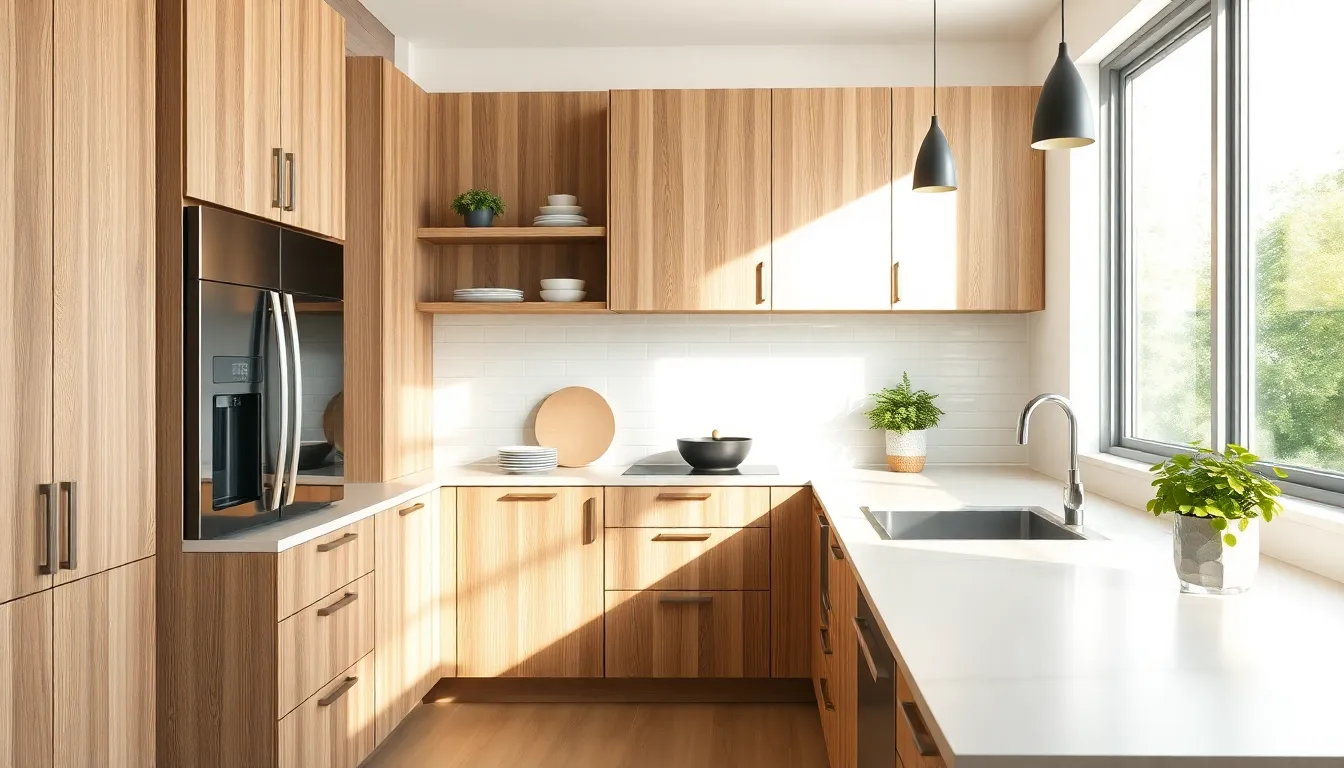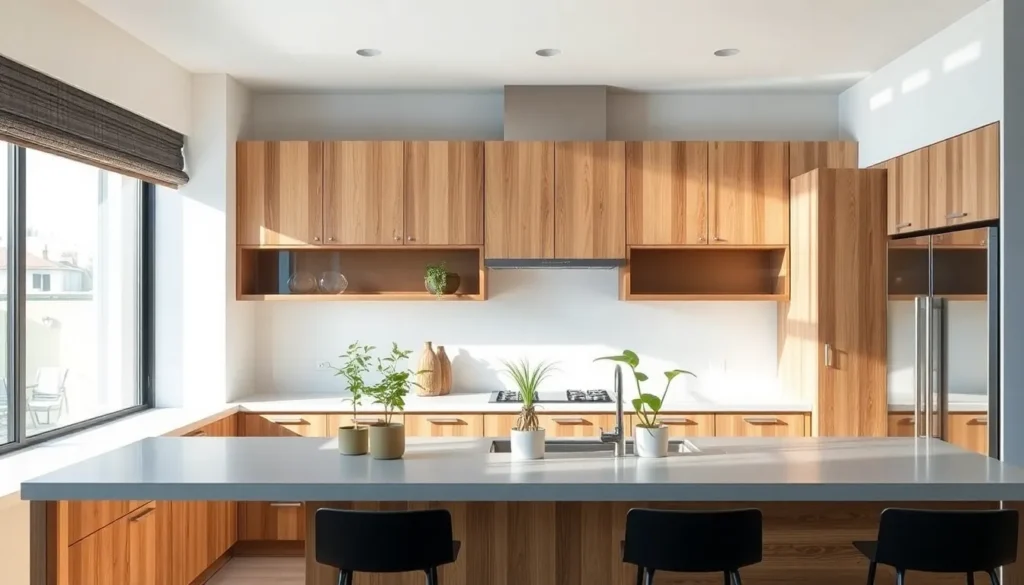In a world where sustainability is the new black, eco-friendly kitchen cabinets are stealing the show. Who knew that saving the planet could look so good? With stylish options that don’t skimp on quality, these cabinets are here to prove that green living isn’t just for tree-huggers anymore.
Imagine opening your kitchen doors to a stunning array of cabinets made from recycled materials or sustainably sourced wood. Not only do they elevate your cooking space, but they also help reduce your carbon footprint. Plus, your friends will be so impressed, they might just start calling you the eco-warrior of home design. So, let’s dive into the world of eco-friendly kitchen cabinets and discover how they can transform your home while keeping Mother Earth smiling.
Eco Friendly Kitchen Cabinets
Eco-friendly kitchen cabinets incorporate sustainable materials, offering durability and style. These cabinets commonly use recycled components, such as reclaimed wood or composite materials, to minimize environmental impact. Many manufacturers adhere to strict guidelines during production, resulting in lower emissions and improved air quality.
When using sustainably sourced wood, the wood often comes from responsible forestry practices that prioritize ecosystem health. Factors such as certifications, like Forest Stewardship Council (FSC) approval, indicate that the wood meets rigorous environmental and social standards. This transparency helps consumers make informed choices.
Designs of eco-friendly cabinets range from modern sleek finishes to rustic charm, catering to various aesthetic preferences. Eco-friendly finishes, such as low-VOC or water-based paints, further enhance indoor air quality, making kitchens healthier spaces. Proven durability means that these cabinets withstand daily wear and tear, reducing the need for replacements over time.
Investing in eco-friendly kitchen cabinets contributes to a sustainable lifestyle. Long-term benefits include lower energy consumption during production and reduced landfill waste when installed. Enhanced resale value often accompanies these energy-efficient choices, as more homeowners seek environmentally responsible options.
Several brands specialize in eco-friendly products, offering customizable solutions to fit specific needs. Research into these brands provides insights into product longevity and performance, ensuring a reliable purchase decision. Choosing eco-friendly kitchen cabinets reflects a commitment to environmental stewardship while enhancing the beauty and functionality of kitchen spaces.
Benefits Of Choosing Eco Friendly Kitchen Cabinets

Eco-friendly kitchen cabinets provide significant advantages, enhancing both home aesthetics and environmental integrity.
Environmental Impact
Sustainable materials play a crucial role in reducing environmental impact. Cabinets made from recycled materials or sustainably sourced wood lower resource depletion. By minimizing the use of harmful chemicals in the production process, these cabinets contribute to cleaner air. Following strict production guidelines, manufacturers reduce emissions during creation. Choosing products with certifications such as Forest Stewardship Council (FSC) approval ensures responsible forestry practices. Such efforts support biodiversity and conserve ecosystems. Overall, selecting eco-friendly options fosters a healthier planet, actively lowering carbon footprints and promoting sustainability.
Health Considerations
Health benefits arise from using eco-friendly kitchen cabinets. These cabinets often feature finishes that emit fewer volatile organic compounds (VOCs), resulting in improved indoor air quality. Exposure to high levels of VOCs can cause respiratory issues and other health problems. Choosing low-VOC options significantly reduces these risks. Additionally, the use of natural materials fosters a healthier living environment. Budget for eco-friendly products also often includes durable options, contributing to long-lasting designs that delay replacement needs. Investing in these cabinets promotes wellness for both residents and the surrounding environment.
Types Of Eco Friendly Kitchen Cabinets
Eco-friendly kitchen cabinets come in various styles and materials, catering to diverse tastes while promoting sustainability. Choices often revolve around the material used and the manufacturing processes involved.
Materials Used
Reclaimed wood features prominently in eco-friendly kitchen cabinets, providing a rustic yet chic aesthetic. Bamboo also stands out due to its rapid growth and renewability. Composite materials made from recycled plastics or wood fibers serve as durable alternatives, combining style with environmental benefits. Additionally, some cabinets utilize low-VOC finishes, reducing harmful emissions and improving indoor air quality. Each of these materials reflects a commitment to sustainability while enhancing kitchen design.
Manufacturing Processes
Sustainable manufacturing processes play a crucial role in producing eco-friendly cabinets. Many manufacturers prioritize local sourcing, minimizing transportation emissions and supporting local economies. Water-based adhesives and finishes commonly ensure lower levels of harmful chemicals during production. Advanced techniques in woodworking reduce waste significantly, allowing for more efficient use of materials. Certifications such as FSC indicate adherence to responsible practices, assuring consumers of the product’s sustainability and quality. These environmentally conscious methods emphasize responsible craftsmanship while enhancing the product’s appeal.
How To Choose Eco Friendly Kitchen Cabinets
Selecting eco-friendly kitchen cabinets involves careful consideration of materials and design elements. Sustainable choices enhance both aesthetics and environmental impact.
Certifications To Look For
Look for cabinets certified by organizations like the Forest Stewardship Council (FSC). Such certifications ensure responsible forestry practices and promote sustainable sourcing. Additionally, products may feature GreenGuard certification, which guarantees low emissions and improved indoor air quality. Other reputable certifications include the Sustainable Forestry Initiative (SFI) and the Cradle to Cradle certification, focusing on recyclability and responsible manufacturing. Prioritize cabinets with these certifications to verify their environmental integrity and quality.
Design Considerations
Evaluate design preferences alongside eco-friendly features. Cabinets made from reclaimed wood often showcase unique textures and histories. Bamboo offers a modern aesthetic with strength and durability. Composite materials integrate various sustainable resources, allowing for a variety of styles while minimizing waste. Color options play a role, so consider non-toxic, low-VOC finishes that enhance indoor air quality. Ensuring a blend of style and sustainability leads to a beautiful, environmentally friendly kitchen space.
Conclusion
Choosing eco-friendly kitchen cabinets is a significant step toward creating a sustainable home. These cabinets not only elevate the kitchen’s aesthetic appeal but also promote environmental responsibility. By selecting materials that are responsibly sourced and manufactured, homeowners can enjoy the benefits of durability and style while contributing to a healthier planet.
The long-term advantages of eco-friendly cabinets extend beyond aesthetics, offering improved indoor air quality and lower energy consumption. As more individuals seek to make environmentally conscious choices, investing in these sustainable options can enhance the overall value of a home. Embracing eco-friendly kitchen cabinets is not just a design choice; it’s a commitment to a greener future.

